 , 雷振, 黄兴园, 王俊, 李倩, 陈荣
, 雷振, 黄兴园, 王俊, 李倩, 陈荣

西安建筑科技大学, 环境与市政工程学院, 西安 710055
收稿日期: 2019-06-25; 修回日期: 2019-08-04; 录用日期: 2019-08-04
基金项目: 国家重点研发计划(No.2017YFE0127300);陕西省重点研发计划国际合作项目(No.2018KWZ-06);陕西省创新团队项目(No.2019TD-025)
作者简介: 杨舒茗(1995—), 女, E-mail:shumingyoung@126.com
通讯作者(责任作者): 陈荣(1980—), 男, 教授, 博士生导师, 主要研究方向:水处理理论与技术, 污水处理与资源化. E-mail: chenrong@xauat.edu.cn
摘要: 本研究分别启动了厌氧膜生物反应器(anaerobic membrane bioreactor,AnMBR)和部分亚硝化-厌氧氨氧化反应器(Partial Nitrification/Anammox,PN/A),两者达到稳态后耦合为"AnMBR+PN/Anammox"新系统,实现前段有机质甲烷化、后段自养脱氮的污水处理目的.耦合系统运行结果表明:化学需氧量(chemical oxygen demand,COD)在AnMBR的去除率为96%,其中80.3%的COD在此段转化为CH4,Anammox内一定的反硝化作用进一步强化了COD去除,系统COD总去除率达97%以上;氮污染物经AnMBR处理后均以NH4+-N形态存在,再经PN/A处理后,总氮(total nitrogen,TN)平均去除率达78%;系统出水COD和TN值分别低于13和11 mg·L-1.因此,AnMBR-Anammox耦合系统在同步实现污水甲烷回收、自养脱氮、低碳氮排放方面具有显著优势,本研究结果为开发AnMBR-Anammox耦合新工艺提供了理论依据.
关键词:厌氧膜生物反应器厌氧氨氧化耦合甲烷回收自养脱氮
Study on characteristics of coupled AnMBR-Anammox for biogas recovery and autotrophic nitrogen removal in domestic wastewater treatment
YANG Shuming
 , LEI Zhen, HUANG Xingyuan, WANG Jun, LI Qian, CHEN Rong
, LEI Zhen, HUANG Xingyuan, WANG Jun, LI Qian, CHEN Rong

School of Environmental and Municipal Engineering, Xi'an University of Architecture and Technology, Xi'an 710055
Received 25 June 2019; received in revised from 4 August 2019; accepted 4 August 2019
Abstract: This study set-up an anaerobic membrane bioreactor (AnMBR) and a partial nitrification-anaerobic ammonia oxidation reactor (PN/Anammox), separately, and then two system were coupled to the "AnMBR+PN/Anammox" to achieve organics removal in AnMBR and post-autotrophic denitrification in PN/A. Results show that the COD removal efficiency in AnMBR was 96%, 80.3% of which was converted into CH4. The total COD removal efficiency of the coupled system exceeded 97% due to the denitrification in PN/A unit. AnMBR converted nitrogen pollutants into NH4+-N because of ammoniation. After PN/A treatment, the average TN removal efficiency was 78%. The COD and TN concentrations in effluent were lower than 13 and 11 mg·L-1, respectively. The AnMBR-Anammox coupled system has significant advantages in simultanous wastewater methane recovery, autotrophic nitrogen removal and low carbon/nitrogen emission. The results of this study provide a theoretical basis for the development of the new AnMBR-Anammox coupling process.
Keywords: AnMBRanammoxcoupling processbiogas recoveryautotrophic nitrogen removal
1 引言(Introduction)近年来, 集污染物削减与能源同步回收的绿色、低碳新技术开发与应用已成为城市污水处理领域发展的新趋势(曲久辉等, 2014).厌氧技术凭借其能够将污水中有机物转化为甲烷的能源回收优势受到了越来越多的关注.虽然厌氧处理已经成功用于高浓度的污废水处理(Dereli et al., 2012; Lin et al., 2013; Yurtsever et al., 2015), 但对于低强度城市污水而言, 微生物增长缓慢、有机物转化效率低等问题仍限制了传统厌氧技术的应用及推广(Lin et al., 2013).厌氧膜生物反应器(Anaerobic membrane bioreactors, AnMBRs)能够实现水力停留时间和污泥龄的完全分离的特点使得城市污水高效稳定能源回收成为可能(Chen et al., 2017), 但是如何在AnMBR强化城市污水有机物能源化的前提下有效实现氮的削减仍是目前亟待解决的问题.
AnMBR出水低C/N的特点, 使得氮素无法通过传统的硝化-反硝化工艺处理, 而需要采用对碳源需求较少或者不需要外加碳源的污水处理方法.厌氧氨氧化(Anaerobic Ammonia Oxidation, Anammox)是20世纪90年代发现的新型的生物自养脱氮途径(Mulder et al., 1995), 该工艺是在厌氧条件下由厌氧氨氧化菌(anammox)利用NO2-将NH4+氧化为N2的生物反应过程, 由于不需要有机物参加, 该工艺能实现在低C/N条件下的高效的氮素去除(Kuenen, 2008).目前, Anammox工艺已在牲畜废水厌氧消化液(Joss et al., 2009; Daverey et al., 2013; Magrí et al., 2013;Frison et al., 2018), 污泥厌氧消化液(Mulder et al., 2001; Xua et al., 2018)等领域得到应用, 并取得较好的处理效果.然而, 侧流厌氧出水中较高的C/N会影响anammox菌的活性及反应器的脱氮效率(Daverey et al., 2013).
本研究提出基于AnMBR耦合Anammox城市污水处理的新型工艺.AnMBR作为前处理单元, 基于膜分离的强化作用, 可实现在处理低浓度城市污水时保留足够的生物量, 提高有机物去除效率.同时, 由于厌氧氨化作用, AnMBR出水中的有机氮均转化为NH4+-N (Ho et al., 2010), 最大程度挖潜了可被Anammox过程所利用的氮.此外, AnMBR出水中存在少量的有机物还可以进一步通过反硝化脱氮等辅反应去除, 既提高了总氮去除率(Chen et al., 2009), 也达到了深度去除有机物的目的.
2 材料与方法(Materials and methods)2.1 实验装置该耦合系统包含一个有效体积为6.0 L(总体积10.0 L)的AnMBR反应器, 以及一个部分亚硝化-厌氧氨氧化(Partial Nitrification/Anammox, PN/A)反应器.PN/A反应器由一个有效体积为1.0 L(总体积1.3 L)的序批式(Sequencing batch reactor, SBR)反应器以及运行体积为2.3 L(总体积3.0 L)的上流式厌氧污泥床反应器(Up-flow anaerobic sludge bed, UASB)组成.AnMBR与SBR、SBR与UASB间各设一个调节池, 有效容积均为0.5 L, 系统流程如图 1所示.AnMBR内置氯化聚乙烯材质平板膜(Kutoba Membrane Cartridge;日本)组件, 有效膜面积为0.116 m2, 膜孔径为0.2 μm, 反应器进出水采用蠕动泵(BT100J-1A, 慧宇;中国)控制, 通过泵不同频率的启闭来控制所设定的水力停留时间(hydraulic retention time, HRT).膜组件和出水蠕动泵之间安装压力变送器(SIN-PX400, 联测;中国)实时监测跨膜压差(Transmembrane pressure, TMP).反应器产生的生物沼气由湿式气体流量计(LMF-1)测量, 并由真空泵(VBY7506-24V, 气海;中国)以5 L·min-1的流速进行循环曝气以控制膜污染.SBR反应器进出水通过定时装置控制蠕动泵开关实现, 反应器间歇曝气采用增氧机(金利佳;中国)实现, 曝气量通过玻璃转子流量计(LZB-3WB, 双环;中国)控制.UASB反应器采用连续进水, 溢流出水的方式运行.整个反应系统采用恒温水浴装置进行温度控制, 使温度维持在(25±1) ℃.
图 1(Fig. 1)
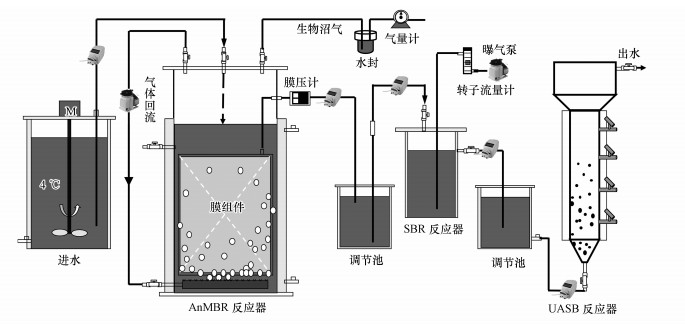 |
| 图 1 耦合系统反应流程图 Fig. 1Schematic diagram of coupled AnMBR-Anammox reactor |
2.2 接种污泥与实验进水AnMBR反应器中污泥取自西安汉斯啤酒厂中温污泥厌氧消化池, PN/A反应器污泥取自西安某污水厂A2O缺氧池末端.反应系统进水采用人工配置的模拟城市污水, 实验进水配方如表 1所示.化学需氧量(chemical oxygen demand, COD)为(500 ± 50) mg·L-1, 总氮(total nitrogen, TN)浓度为(50 ± 5) mg·L-1.
表 1(Table 1)
| 表 1 实验进水成分 Table 1 Composition of the synthetic wastewater | ||||||||||||||||||||||||||||||||||||
表 1 实验进水成分 Table 1 Composition of the synthetic wastewater
| ||||||||||||||||||||||||||||||||||||
2.3 反应器运行工况本研究首先将AnMBR以及PN/A分置启动, 当各自稳定运行后, 再将两套反应器进行耦合污水处理.反应器具体运行工况如表 2所示.
表 2(Table 2)
| 表 2 反应器运行工况 Table 2 Operational condition of reactors | ||||||||||||||||||||||||||||||||||||||||||||||||||||||||
表 2 反应器运行工况 Table 2 Operational condition of reactors
| ||||||||||||||||||||||||||||||||||||||||||||||||||||||||
2.4 anammox菌活性实验取耦合系统稳定运行后的Anammox反应器底部泥水混合物20 mL置于120 mL血清瓶中, 添加NH4+-N, NO2--N浓度各为100 mg·L-1的基质60 mL, 使用氮气排出血清瓶中空气后密封装瓶, 放入25 ℃恒温摇床中120 r·min-1振荡.每隔2 h采用玻璃注射器测产气量, 总取样7次.以时间为横坐标, 产气量(0 ℃, 1.01×105 Pa)为纵坐标作拟合曲线, 计算活性值(Chen et al., 2019).
2.5 分析项目与检测方法COD分析采用快速消解分光光度法, TN的测定采用碱性过硫酸钾法, NH4+-N采用纳氏试剂分光光度法, NO2--N采用N-(1-萘基)-乙二胺分光光度法, NO3--N采用紫外分光光度法.悬浮固体浓度(MLSS) 及挥发性悬浮固体浓度(MLVSS)的测定采取重量法.AnMBR产生的生物沼气组分(CH4、N2、H2以及CO2)采用气相色谱(GC 7900;天美, 中国)测定, 色谱柱:碳分子TDX-01, 柱温箱温度145 ℃, 检测器温度150 ℃.
溶解性CH4的测定采用顶空法(Hatamoto et al., 2010), 向122 mL血清瓶中加入14.7 g氯化钠后密封, 并使用水环式真空泵抽真空.向血清瓶中注入41.5 mL AnMBR出水后放入摇床, 在150 r·min-1, 25 ℃条件下振荡10 min, 再用玻璃注射剂向血清瓶中缓缓加入饱和氯化钠溶液至瓶中压力与大气压一致, 记录注射溶液体积, 稳定5 min后用上述气相色谱测定CH4比例, 计算出单位体积出水中的CH4量.
3 结果与讨论(Results and discussion)3.1 AnMBR启动如图 2所示, AnMBR在HRT 24 h(OLR=0.5 g·L-1·d-1)下运行40 d后缩短至12 h(OLR=1.0 g·L-1·d-1)并稳定运行32 d, 在启动期内反应器中MLVSS维持在6.0~8.5 g·L-1.在启动前期, 出水COD从48.4 mg·L-1逐渐减小, 启动6 d后出水COD稳定在30.0 mg·L-1以下, CH4产量保持在0.600 L·d-1以上, 表明AnMBR反应器能够实现短时间内的快速启动.随着运行时间延长, 污泥活性增强, 出水COD逐渐稳定在20.2 mg·L-1, 有机物去除率高达96%.CH4产量从HRT 24 h时的0.113 L·L-1·d-1(每升反应器每天CH4产量(L), 下同)增加至HRT 12 h时的0.227 L·L-1·d-1.生物沼气中CH4含量逐渐增加, 运行28 d后, 气体中CH4比例稳定在84%, 该反应器中CH4含量明显高于传统厌氧发酵的60%, CO2比例稳定在4%, 是一种高品质的生物沼气.
图 2(Fig. 2)
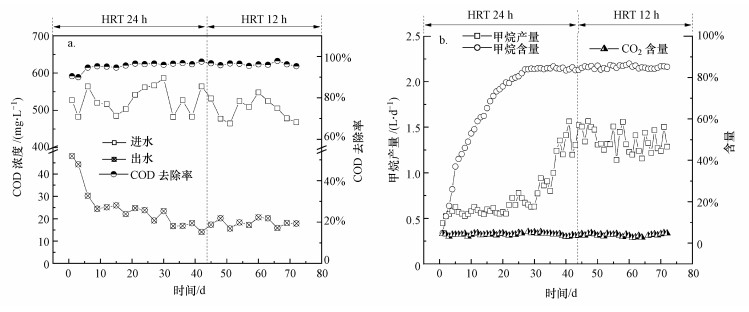 |
| 图 2 AnMBR启动阶段处理效果 (a.进出水COD及去除率, b. CH4产量及生物沼气中CH4、CO2含量) Fig. 2Treatment performance of AnMBR at start-up period |
3.2 PN/A启动如表 3所示, 在PN/A反应器分置启动阶段, 在出水NH4+-N和NO2--N浓度逐渐降低, TN去除率稳步上升的同时缩短HRT, 逐步提高反应器负荷.
表 3(Table 3)
| 表 3 启动阶段PN/A反应器运行方式 Table 3 Operational condition of PN/A unit at start-up period | |||||||||||||||||||||||||
表 3 启动阶段PN/A反应器运行方式 Table 3 Operational condition of PN/A unit at start-up period
| |||||||||||||||||||||||||
在启动第Ⅰ阶段, 由于接种污泥活性较差, 选择在长HRT (7 h)条件下运行, 出水TN浓度从50.2 mg·L-1逐渐降低至19.4 mg·L-1, 去除率达64%(图 3).在第Ⅱ阶段, 提高反应器氮负荷, 增加曝气量以及曝气时间, 反应器中溶解氧依然保持在较低水平(0.2~0.28 mg·L-1), Anammox出水NH4+-N浓度7.57 mg·L-1, 而NO2--N浓度依然较高(5.84 mg·L-1).在第Ⅲ阶段提高氮负荷至1.0 g·L-1·d-1增大曝气量至0.09 m3·h-1, PN中溶解氧为0.16~0.26 mg·L-1, Anammox出水中NH4+-N浓度为5.67 mg·L-1, NO2--N浓度减少至2.58 mg·L-1.在第51 d后, 总氮去除率稳定在70%以上, 成功实现了PN/A的启动.为进一步提高TN去除率, 自68 d起(第Ⅳ阶段)对曝气方式进行进一步优化, 此后PN/A的氮去除效果逐步增加, TN去除率稳定在72%以上.对启动成功后的反应器进行氮素流动分析发现:Anammox出水中NO3--N相对PN出水增加量仅为2.54 mg·L-1, 远低于依据公式(1)理论计算得到的5.56 mg·L-1, 这可能是由于Anammox中存在着反硝化过程而导致的出水NO3--N低于理论值.
图 3(Fig. 3)
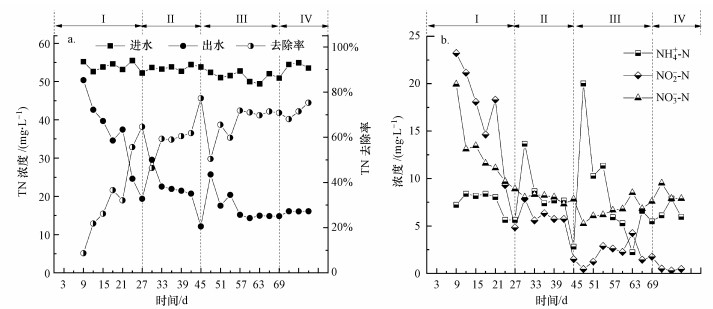 |
| 图 3 启动阶段PN/A反应器氮素去除效果 (a.进出水TN浓度及去除率, b. Anammox出水NH4+-N, NO2--N, NO3--N浓度) Fig. 3Nitrogen removal performance of PN/A unit during start-up period |
 | (1) |
图 4(Fig. 4)
 |
| 图 4 耦合系统COD去除效果 (a.系统进出水COD浓度, b.系统COD去除率) Fig. 4COD treatment performance of coupled AnMBR-Anammox |
耦合系统中的COD去向主要包括CH4生产(包括生物沼气中CH4以及出水中的溶解性CH4)、微生物生长利用、反硝化利用以及出水中未降解的COD.该系统中产生的溶解性CH4占总CH4产量的10%, 系统进水中77.5%的COD最终转化为CH4, 占去除的COD的80.3%, 表明该AnMBR反应器具有高效的CH4转化效率以及能源回收潜能.微生物生长所需COD占总进水COD的12.5%.计算得到AnMBR中污泥产率为0.09 g·g-1(MLVSS的质量占去除的COD的质量, 下同), 与厌氧消化理论污泥产量0.03~0.18 g·g -1的范围一致, 显著低于传统好氧处理的0.25 ~ 0.4 g·g -1的污泥产率(Huang et al., 2001).AnMBR出水中未降解的COD占总进水的3.28%, 此部分COD经过Anammox中反硝化过程可以进一步去除, 使得系统最终出水达到很低的COD值.然而, 在COD平衡中, 仍然存在6.76%的COD损失导致其无法平衡, 这可能是进水COD自然降解以及气体计量误差所导致的.
图 5(Fig. 5)
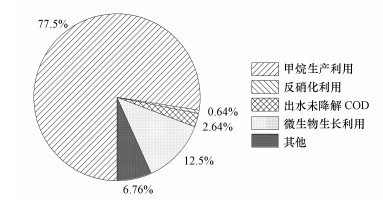 |
| 图 5 耦合系统COD平衡分析 Fig. 5COD balance of coupled AnMBR-Anammox |
图 6(Fig. 6)
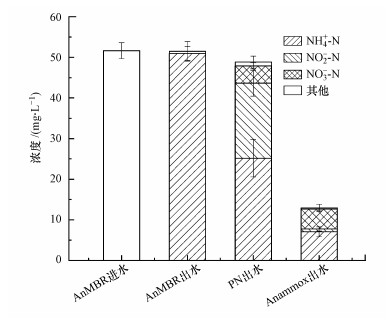 |
| 图 6 耦合系统氮去除效果 Fig. 6Nitrogen removal performance of coupled AnMBR-Anammox |
3.3.2 耦合系统的氮转化及去除分析耦合系统最终出水TN浓度约为11 mg·L-1, TN去除率达78.4%.各处理单元中氮素的转化及去除结果分析表明:AnMBR反应器中, 进水主要是有机氮形式, TN浓度为51.5 mg·L-1, 通过厌氧氨化作用, 将进水中的有机氮全部转化为NH4+-N.PN中存在50.6%的NH4+-N转化率, 低于理论值57%, 需通过调整曝气方式进一步提高NH4+-N转化率.PN出水中NO2--N浓度为25.2 mg·L-1, NO3--N浓度为4.26 mg·L-1;PN出水经后段Anammox及反硝化过程利用后出水NO2--N及NO3--N浓度分别为0.69 mg·L-1和4.84 mg·L-1, 表明Anammox过程几乎完全利用PN出水中的NO2--N, 而Anammox中NO3--N浓度较PN出水几乎没有增加, 说明Anammox中反硝化利用NO3--N能力较耦合之前有所增强.
分别对接种污泥以及在耦合系统稳定运行后Anammox反应器底部污泥进行anammox菌活性实验.结果如图 8所示, 接种污泥中anammox菌的活性为0.432 mg·g-1·d-1(每克MLVSS每天产生的N的质量(mg), 下同), 耦合系统稳定运行阶段中, Anammox反应器底部anammox菌活性为254 mg·g-1·d-1, 与类似反应器中anammox菌活性相当(He et al., 2018; Tang et al., 2011).
图 7(Fig. 7)
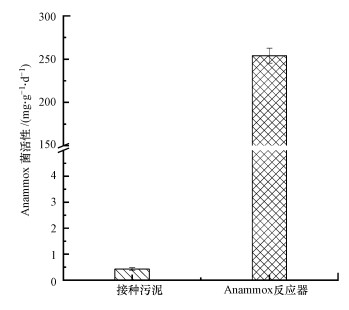 |
| 图 7 anammox菌活性实验结果 Fig. 7Specific anammox activity results |
对比本研究和文献中记载的城市污水厌氧处理与Anammox结合工艺(表 4)发现, 虽然已经部分研究实现了较高的TN、有机物去除, 但是均存在HRT过长的问题.在实际污水处理中, 较长的HRT会导致污水处理构筑物体积过大, 加大建设投资.本研究中, AnMBR反应器HRT 7.2 h, PN/A反应器HRT 4 h条件下, 实现了总HRT<12 h条件下对低强度污水(500 mg·L-1 COD, 50 mg·L-1 TN)的高效COD(97.4%)及TN(78.4%)的高效去除, 并且实现了很高的甲烷回收率(80.3%).
表 4(Table 4)
| 表 4 Anammox处理城市污水厌氧发酵污水的研究报道 Table 4 Performance of existing Anammox treating anaerobically-treated effluent | ||||||||||||||||||||||||||||||||||||||||||||||||||||||||||||
表 4 Anammox处理城市污水厌氧发酵污水的研究报道 Table 4 Performance of existing Anammox treating anaerobically-treated effluent
| ||||||||||||||||||||||||||||||||||||||||||||||||||||||||||||
5 结论(Conclusions)本研究成功实现了AnMBR-Anammox耦合城市污水处理系统的快速启动及稳定运行.耦合系统在总HRT为11.2 h条件下, 实现97.4%的总COD去除率以及78.4%的TN去除率, 其中80.3%的COD转化成CH4, 实现高效的能源回收.研究结果表明, 通过AnMBR-Anammox耦合可以实现污水中能源高效回收、有机物及氮素高效去除, 是一种极具发展前景的污水处理新工艺.
参考文献
| Chen H, Liu S, Yang F, et al. 2009. The development of simultaneous partial nitrification, ANAMMOX and denitrification (SNAD) process in a single reactor for nitrogen removal[J]. Bioresource Technology, 100: 1548–1554.DOI:10.1016/j.biortech.2008.09.003 |
| Chen R, Nie Y, Hu Y, et al. 2017. Fouling behaviour of soluble microbial products and extracellular polymeric substances in a submerged anaerobic membrane bioreactor treating low-strength wastewater at room temperature[J]. Journal of Membrane Science, 531: 1–9.DOI:10.1016/j.memsci.2017.02.046 |
| Chen R, Takemura Y, Liu Y, et al. 2019. Using partial nitrification and anammox to remove nitrogen from low-strength wastewater by co-immobilizing biofilm inside a moving bed bioreactor[J]. ACS Sustainable Chemistry & Engineering, 7: 1353–1361. |
| Dai W, Xu X, Liu B, et al. 2015. Toward energy-neutral wastewater treatment:A membrane combined process of anaerobic digestion and nitritation-anammox for biogas recovery and nitrogen removal[J]. Chemical Engineering Journal, 279: 725–734.DOI:10.1016/j.cej.2015.05.036 |
| Daverey A, Hung N T, Dutta K, et al. 2013. Ambient temperature SNAD process treating anaerobic digester liquor of swine wastewater[J]. Bioresource Technology, 141: 191–198.DOI:10.1016/j.biortech.2013.02.045 |
| Dereli R K, Ersahin M E, Ozgun H, et al. 2012. Potentials of anaerobic membrane bioreactors to overcome treatment limitations induced by industrial wastewaters[J]. Bioresource Technology, 122: 160–70.DOI:10.1016/j.biortech.2012.05.139 |
| Fernandes L d A, Pereira A D, Leal C D, et al. 2018. Effect of temperature on microbial diversity and nitrogen removal performance of an anammox reactor treating anaerobically pretreated municipal wastewater[J]. Bioresource Technology, 258: 208–219.DOI:10.1016/j.biortech.2018.02.083 |
| Frison N, Malamis S, Katsou E, et al. 2018. Enhanced retention of deammonification microorganisms for the treatment of psycrophilic anaerobic digestate[J]. Chemical Engineering Journal, 344: 633–639.DOI:10.1016/j.cej.2018.03.053 |
| Hatamoto M, Yamamoto H, Kindaichi T, et al. 2010. Biological oxidation of dissolved methane in effluents from anaerobic reactors using a down-flow hanging sponge reactor[J]. Water Research, 44: 1409–1418.DOI:10.1016/j.watres.2009.11.021 |
| He S, Chen Y, Qin M, et al. 2018. Effects of temperature on anammox performance and community structure[J]. Bioresource Technology, 260: 186–195.DOI:10.1016/j.biortech.2018.03.090 |
| Ho J, Sung S. 2010. Methanogenic activities in anaerobic membrane bioreactors (AnMBR) treating synthetic municipal wastewater[J]. Bioresource Technology, 101: 2191–2196.DOI:10.1016/j.biortech.2009.11.042 |
| Huang X, Gui P, Qian Y. 2001. Effect of sludge retention time on microbial behaviour in a submerged membrane bioreactor[J]. Process Biochemistry, 36(10): 1001–1006.DOI:10.1016/S0032-9592(01)00135-2 |
| Joss A, Salzgeber D, Eugster J, et al. 2009. Full-scale nitrogen removal from digester liquid with partial nitritation and anammox in one SBR[J]. Environmental Science & Technology, 43: 5301–5306. |
| Kuenen J G. 2008. Anammox bacteria:from discovery to application[J]. Nature Reviews Microbiology, 6(4): 320–326.DOI:10.1038/nrmicro1857 |
| Leal C D, Pereira A D, Nunes F T, et al. 2016. Anammox for nitrogen removal from anaerobically pre-treated municipal wastewater:effect of COD/N ratios on process performance and bacterial community structure[J]. Bioresource Technology, 211: 257–266.DOI:10.1016/j.biortech.2016.03.107 |
| Li X, Sun S, Yuan H, et al. 2017. Mainstream upflow nitritation-anammox system with hybrid anaerobic pretreatment:Long-term performance and microbial community dynamics[J]. Water Research, 125: 298–308.DOI:10.1016/j.watres.2017.08.048 |
| Lille M V D, Berkhout V, Fr?ba L, et al. 2015. Ammonium estimation in an ANAMMOX SBR treating anaerobically digested domestic wastewater[J]. Chemical Engineering Science, 130: 109–119.DOI:10.1016/j.ces.2015.03.018 |
| Lin H, Peng W, Zhang M, et al. 2013. A review on anaerobic membrane bioreactors:Applications, membrane fouling and future perspectives[J]. Desalination, 314: 169–188.DOI:10.1016/j.desal.2013.01.019 |
| Magrí A, Béline F, Dabert P. 2013. Feasibility and interest of the Anammox process as treatment alternative for anaerobic digester supernatants in manure processing-An overview[J]. Journal of Environmental Management, 131: 170–184. |
| Mulder A, van de Graaf A A, Robertson L A, et al. 1995. Anaerobic ammonium oxidation discovered in a denitrifying fluidized bed reactor[J]. FEMS Microbiology Ecology, 16(3): 177–184. |
| Mulder J W, Loosdrecht M C M, Hellinga C, et al. 2001. Full-scale application of the SHARON process for treatment of rejection water of digested sludge dewatering[J]. Water Science and Technology, 43(11): 127–134.DOI:10.2166/wst.2001.0675 |
| 曲久辉, 王凯军, 王洪臣, 等. 2014.建设面向未来的中国污水处理概念厂[N].中国环境报, 2014-01-07(010) |
| Tang C J, Zheng P, Wanga C H, et al. 2011. Performance of high-loaded Anammox UASB reactors containing granular sludge[J]. Water Research, 45: 135–144.DOI:10.1016/j.watres.2010.08.018 |
| Xua X, Wang G, Zhou L, et al. 2018. Start-up of a full-scale SNAD-MBBR process for treating sludge digester liquor[J]. Chemical Engineering Journal, 343: 477–483.DOI:10.1016/j.cej.2018.03.032 |
| Yurtsever A, Sahinkaya E, Aktas O, et al. 2015. Performances of anaerobic and aerobic membrane bioreactors for the treatment of synthetic textile wastewater[J]. Bioresource Technology, 192: 564–573.DOI:10.1016/j.biortech.2015.06.024 |
